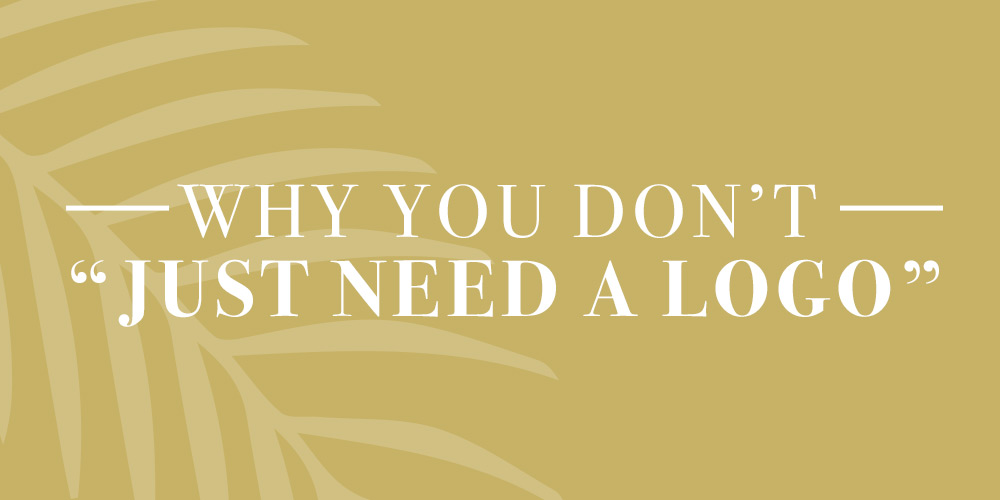
I hear it all the time. I only need a logo.
A logo seems like the obvious first step when you get ready to start marketing your business. You think you need a logo so that you look legitimate. And that’s true to an extent. But I think the biggest mistake that business owners make is that they never do the deep dive brand work that helps you create a really effective brand and strategy. And that doesn’t just come from a logo, friends.
You see, the logo is the final product of the entire branding process. And that process starts with research, strategy and discovering who you are as a brand. There’s that word again–brand. But what is a brand? What does that have to do with a logo and why aren’t they the same thing?
A brand is how your customer experiences your business. For example, it’s the look and feel, it’s the vibe and tone you give off when you speak to them, it’s how they associate your business in their mind. It’s the personality of your business.
And you’ll see that I never mentioned the word logo in that description.
Think about big brands you are familiar with.
Jeep. Apple. Nike.
As you think of these brands, you probably think about how they portray themselves in their marketing. You might have thought about their tagline, and yes you might have associated their logo with the brand. But that’s not the only thing. You probably thought about this:
Jeep=Explorer, outdoors, off-road
Apple=Sleek, innovative, “think different”
Nike=Empowering, athletic, “Just Do It”
The reasons why you were able to think about those other aspects of those companies’ besides the logo is because they’ve branded themselves to be perceived that way through the voice they use to communicate with their audience, the look and feel of their advertising, the photography they use, even the colors they use reinforce their brand.
And a logo is only a small puzzle piece of that.
So, if you thought you just needed a logo, but now you realize you need to better establish your brand, here’s some exercises to get your gears turning.
1.Identify your ideal audience
This sounds really simple. But a lot of small business owners really don’t define this and it makes marketing your business a lot harder because you haven’t focused on who your ideal customer is. And if you don’t know who that person is, you really can’t communicate with them effectively. So start thinking about who your ideal customer is. What is their name (you can base this off of a previous customer who you absolutely loved working with–this helps you really feel like you know that person and since you’ve worked with them, it’s easier to nail down concrete details about that person and their interests and what would appeal to them.
2. Make a word list
Think about all the words that your brand would use to communicate with your ideal customer. What are words that they would use, what are words that would repel them. What are the words that touch on their pain points of their life experience. Make a list of these words and start using those in your social media posts, your emails, and any interaction with your clients. By consistently using similar language when communicating with your customers, they will begin to associate them with your brand and they will also relate your brand because you’re using vocabulary that they are using.
3. If your brand was a guest at a party, who would they be?
This is a question I always include in my brand insights questionnaire with my clients. And it’s my FAVORITE question. This really gives a great indication of your brand personality. I think that this is so important because it’s easy for us to think of our brand as this big abstract thing, but if your brand were an actual person, what would they be like? Would they be the social butterfly always knowing the right thing to say? Are they the person who makes everyone laugh and has a great sense of humor? Are they the edgy, rebellious type who is always known for their rugged style and beating to the tune of their own drum? This exercise will really help you think about your brand and how it’s personality would be perceived.
Think about big brands you know of that have a well established brand (like Jeep, Apple, or Nike like we mentioned) and do this exercise with their brands. For me, Nike comes to mind because if I were to imagine Nike as a person, I would imagine them as the coach that pushes you the hardest because they see your potential. They are the best kind of coach because they empower you and motivate you, and you want to impress them because they believe in you. They expect greatness, and they don’t expect you to do anything they wouldn’t do themselves. They are running along beside you cheering you on and pushing you to your limits at the same time. See–you can totally visualize that person. And when you’ve defined this for yourself, you want to make sure that that personality is coming through in the way you communicate with your audience. And the goal is that if your audience or ideal client was asked “Describe X brand if they were at a party?” that their description of your brand and your description of your brand align. That’s who you know your branding is working.
So yes, you need a logo. But you need a brand first, and once you’ve done the brand strategy work, you’re in a much better place for creating a logo rooted in strategy and meaning.
Are you ready to establish or refine your brand? Click here to schedule a call and we can chat all about your brand strategy!
Until next time!
Jade
comments +